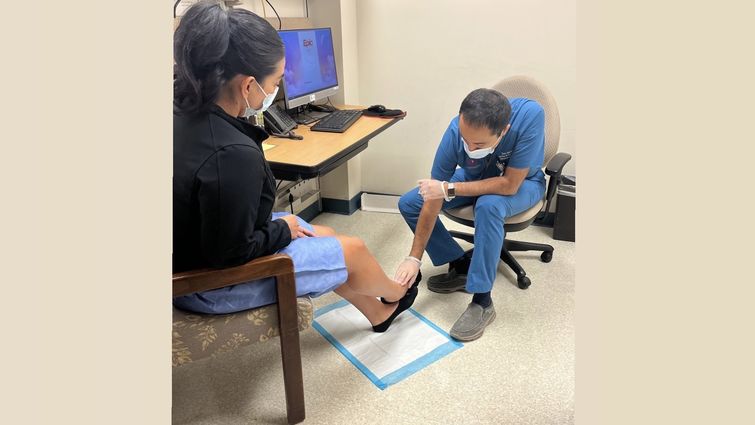
Dr. Mohammed Reza Amini consults a patient about chronic venous insufficiency.
Varicose veins are bulging, twisted veins visible under the skin's surface that signal chronic venous insufficiency (CVI). CVI is a type of venous disease that occurs when the valves in leg veins malfunction; this causes blood to flow backward and pools in the legs instead of going back up to the heart.
As a result, CVI can produce painful and debilitating symptoms of burning, throbbing, itching, swelling, cramping, heaviness, and other pain in the legs. If you suffer from these sensations, you may want to see a vein specialist and consider options for pain relief and treatment for CVI.
Mohammad Reza Amini, MD, director of Peripheral Arterial and Venous Disease services at Loma Linda University International Heart Institute, outlines various minimally invasive treatment options you may consider for alleviating CVI symptoms.
The first step includes talking to your doctor about your symptoms. "Do not hesitate to mention your symptoms and develop an action plan with your doctor as soon as they arise," he says. "It is a good idea to address varicose vein ailments before the chronic venous insufficiency progresses too far and causes irreversible damage."
Depending on the circumstances, your doctor may suggest starting with a “conservative” approach, which consists of making lifestyle and behavioral changes, using wearables such as compression stockings, and taking medications.
Read: How to ease your varicose vein symptom flare-ups in summer heat
If initial conservative attempts fail to alleviate symptoms, Amini says you and your doctor may determine that the best way forward involves an intervention for CVI, generally called venous closure procedures. As the name suggests, venous closure procedures aim to close the veins responsible for fueling, or feeding, the varicose veins. As the varicose veins dissipate, much of the swelling and other painful symptoms associated with CVI will also ease up.
By minimally invasive means involving only local sedation, physicians can close the “feeder veins” in several different venous closure procedures. The type of procedure you choose will hinge on the type of problem you have, your preferences, insurance coverage, and what your provider offers. LLU International Heart Institute provides the following options for minimally invasive venous closure procedures:
- Sclerotherapy: Physicians inject a chemical into the feeder veins that scars them so they can no longer carry blood. Blood then returns to the heart through other veins, and the body absorbs the scarred veins.
- Endovenous laser ablation: A tube (catheter) inserts heat from a laser source right into the affected vein to close the vein. Once the vein closes, less blood pools in the leg, and overall venous flow improves.
- Radiofrequency ablation (RFA): A tube (catheter) inserts heat from radio waves source right into the affected vein to close it. The vein closure ultimately improves overall venous flow.
Amini says all minimally invasive procedures for CVI can occur in an outpatient setting and typically take no more than 45-60 minutes. Minimally invasive venous closures are performed step-wise — one leg vein at a time. So patients may undergo multiple rounds of venous closure intervention via separate appointments. Patients need not halt medications or engage in special prep before undergoing these procedures done at Loma Linda University International Heart Institute.
Physicians will use a map of the patient’s venous system acquired through ultrasound imaging from prior visits to identify which feeder veins to close. Then, during the procedure, physicians employ imaging tools such as ultrasound to guide them as they insert a catheter into the leg veins and shut off the veins.
After the procedure, the patient can move and go about the rest of the day’s activities as usual, Amini says. Patients are asked to avoid placing extreme hot or cold on the area where any catheter was inserted for about five days to help heal. Patients usually return to for an ultrasound check up within two to seven days of the procedure. These checkups are dedicated to ensuring the veins are closed and addressing any patient questions or concerns.
You need to be able to keep the whole picture in mind as you continue to address risk factors and co-morbidities.Dr. Reza Amini
Amini says the minimally invasive venous closure procedures lead to differing short-term side effects; for instance, bruising, numbness and tingling. But, ultimately, as the side effects subside, the procedures all yield similar long-term outcomes, he says — more than 90% success rate of veins remaining closed in five years.
“I haven’t seen patients return with closed veins that have opened again after a venous closure procedure,” says Amini, who has been providing the procedures at LLU International Heart Institute for over eight years. “On the other hand, I have seen the same patients return with new varicose veins that have popped up.”
For this reason, Amini advises you to continue investing time and effort into maintaining your health before and after a venous closure procedure. In addition, he says it is essential to minimize and manage other risk factors for venous disease, such as obesity, hypertension and diabetes. In other words, undergoing the procedure does not absolve you of other health concerns that might arise if you disregard your cardiovascular health; he says it is an aspect of health to maintain constantly.
“You need to be able to keep the whole picture in mind as you continue to address risk factors and co-morbidities,” he says. “Listen to your body, be conscious of how you feel, and don’t wait to explore your options if you are in pain from chronic venous insufficiency.”
At Loma Linda University International Heart Institute, physicians are committed to providing patients with compassionate, comprehensive, and personalized cardiovascular care. To learn more, please visit lluh.org/heart-vascular or call 1-800-468-5432 to make an appointment.
